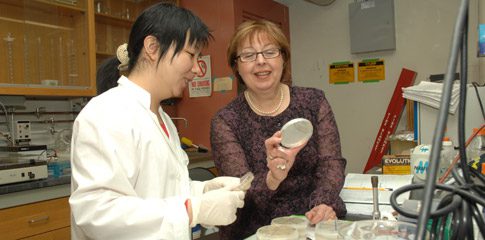Faculty Info
Name: Corinne A. Michels
Title:Distinguished Professor of Biology
Department: Biology
Degree(s): BS, Queens College PhD, Columbia University
Contact Information:
Phone: (718) 997-3410
Office: Science Building E102
Email: Corinne.Michels@qc.cuny.edu
“Genetics is like mathematics—when designing an experiment to test your hypothesis much of the work goes on in your head. Keep in mind that if your organism has a long life cycle, like corn, a poorly conceived experiment could waste years of work and lots of money.”
– Corinne A. Michels
Past Profiles

Dr. Michels and a doctoral student examine bacterial strains carrying different cloned DNA fragments that will be used to repress gene expression.
Corinne A. Michels views genetics as a tool to understand the mysteries of life. For years, she studied baker’s yeast, the single-celled organism whose growth and reproduction is governed by some 6,200 genes. It was the first higher organism genome sequenced, finished in 1996, by an international consortium and set the stage for the Human Genome Sequencing project. According to Michels, “Yeast cells reproduce in less than two hours and a mating cycle takes about three days. That’s why it is a popular genetic model organism.”
What captivates Michels is the fact that an organism’s genes act differently—some become active only when signaled to do so by environmental stimuli while others are active at all times. How are these different states regulated and how are specific stimuli sensed? To answer these questions, she chose what initially appeared to be a simple set of genes in baker’s yeast that respond to the presence of the sugar, maltose. This seemingly simple system has turned out to be anything but simple and has taken Michels into many unexpected areas of investigation and made for an exciting journey of discovery. The results have implications for a variety of human diseases, including cancer, which develops when cells are not properly regulating the genes controlling cell multiplication. Aspects of her work even relate to diabetes and cystic fibrosis.
“We’ve figured out one example of gene regulation in baker’s yeast,” says Michels. “It’s important because of its relevance for multi-celled organisms. During embryological development you have the single cell, the fertilizer egg that divides to form many cells that are quite different in character, such as muscle cells or liver cells. They differ because different genes are active in these different cells. Well, how did this happen? Basically, they receive different signals at an early stage in development that turn on different genes and send them down different pathways with different developmental endpoints.”
Michels, who earned her doctorate at Columbia University, began teaching at QC in 1972 after doing post-doctoral research at the Albert Einstein College of Medicine in the Bronx. Close to four decades later, she’s continuing her research while administering the college’s Biology Department, with 21 full-time professors, about 20 doctoral students who also teach, six laboratory technicians that support the department’s teaching effort, and another 20 or so adjunct professors. It’s a logistical challenge but “very rewarding”, says Michels.
During a recent sabbatical, Michels laid the groundwork for a new research project. After close to four decades studying baker’s yeast, she’s ready to apply her genetics expertise to the study of human disease. She has joined an NIH clinical study of the inherited disorder called Ushers Syndrome, which causes deafness, progressive blindness, and balance problems. The goal is to see if the severity of the symptoms can be correlated with the specific genetic mutation. “You get to different points in your life when change is good,” she says. “I’m now interested in applying what we have learned in the model genetic systems to inherited human disease.”
Book everyone should read: Mutants: On Genetic Variety and the Human Body, by Armand Marie Leroi
Surprising fact: She’s an opera lover and since the 1990s has shared season tickets at the Metropolitan Opera with a scientist/friend from graduate school.

